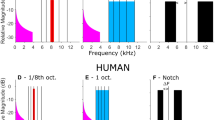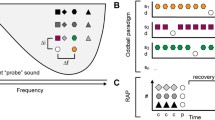Abstract
Broadband sounds originating in the median plane are thought to be localized by neural processing of spectral notches introduced by the filtering action of the pinnae. Previous studies (Nelken, I., and E. D. Young. J. Neurophysiol. 71:2446–2462, 1994; Spirou, G. A., and E. D. Young. ibid. 66: 1750–1768, 1991) suggested that type IV units in decerebrate cat dorsal cochlear nucleus (DCN) are functional detectors of these spectral notches. Intracellular marking studies by Ding et al. (Ding, J., T. E. Benson, and H. F. Voigt. J. Neurophysiol. 82:3434–3457, 1999) have shown that type III units in gerbil arise from the DCN's principal output neurons, which are thought to have type IV unit properties in cat. A relative paucity of type IV units in the decerebrate gerbil (Davis, K. A., J. Ding, T. E. Benson, and H. F. Voigt. J. Neurophysiol. 75: 1411–1431, 1996) has motivated this study of spectral notch sensitivity in the gerbil DCN. Responses to notch noise stimuli were recorded from 15 gerbil type III units to investigate whether these units may function as spectral notch detectors. For narrow notch noise stimuli, all 15 units showed excitatory responses. For progressively wider notches, the discharge rate of 13/15 units became inhibited. As the maximum limits of notch width were approached, 11/15 units showed some degree of recovery from this inhibition. This response pattern in gerbil type III units possesses the salient features of notch noise responses in cat type IV units and implicates type III units in gerbilline spectral notch detection processes. © 2001 Biomedical Engineering Society.
PAC01: 4366Gf, 8719Dd, 8719La, 4364Dw
Similar content being viewed by others
REFERENCES
Blauert, J. Spatial He#x00C5: The Psychophysics of Human Sound Localization. Cambridge, MA: MIT Press, 1983.
Davis, K. A., J. Ding., T. E. Benson., and H. F. Voigt. Response properties of units in the dorsal cochlear nucleus of unanesthetized decerebrate gerbil. J. Neurophysiol.75.:1411–1431., 1996.
Davis, K. A., G. T. Gdowski., and H. F. Voigt. A statistically based method to generate response maps objectively. J. Neurosci. Methods.57.:107–118., 1995.
Davis, K. A., and H. F. Voigt. Evidence of stimulus-dependent correlated activity in the dorsal cochlear nucleus of decerebrate gerbils. J. Neurophysiol.78.:229–247., 1997.
Ding, J., T. E. Benson., and H. F. Voigt. Acoustic and current-pulse responses of identified neurons in the dorsal cochlear nucleus of unanesthetized decerebrate gerbil. J. Neurophysiol.82.:3434–3457., 1999.
Evans, E. F., and P. G. Nelson. The responses of single neurons in the cochlear nucleus of the cat as a function of their location and anesthetic state. Exp. Brain Res.17.:402–427., 1973.
Frisina, R. D., S. C. Chamberlain., M. L. Brachman., and R. L. Smith. Anatomy and physiology of the gerbil cochlear nucleus: An improved surgical approach for microelectrode studies. Hear. Res.6.:259–275., 1982.
Hancock, K. E., and H. F. Voigt. Wide-band inhibition of dorsal cochlear nucleus type IV units in cat: A computational model. Ann. Biomed. Eng.27.:73–87., 1999.
Lay, D. M., Differential predation on gerbils by the Little Owl, Athene-Brahma. J. Mammal.55.:608–614., 1974.
Nelken, I., and E. D. Young. Two separate inhibitory mechanisms shape the responses of dorsal cochlear nucleus type IV units to narrow-band and wide-band stimuli. J. Neurophysiol.71.:2446–2462., 1994.
Rice, J. J., B. J. May., G. A. Spirou., and E. D. Young. Pinna-based spectral cues for sound localization in cat. Hear. Res.58.:132–152., 1992.
Searle, C. L., L. D. Braida., D. R. Cuddy., and M. F. Davis. Binaural pinna disparity: Another auditory localization cue. J. Acoust. Soc. Am.57.:448–455., 1975.
Shofner, W. P., and E. D. Young. Excitatory/inhibitory response types in the cochlear nucleus: Relationships to discharge patterns and responses to electrical stimulation of the auditory nerve. J. Neurophysiol.54.:917–939., 1985.
Spirou, G. A., and E. D. Young. Organization of dorsal cochlear nucleus type IV unit response maps and their relationship to activation by band-limited noise. J. Neurophysiol.66.:1750–1768., 1991.
Voigt, H. F., and K. A. Davis. Computer simulations of neural correlations in the dorsal cochlear nucleus. In: Cochlear Nucleus: Structure and Function in Relation to Modeling, edited by W. A. Ainsworth. London: JAI Press, 1996, pp. 351–375.
Voigt, H. F., K. E. Hancock, J. Ding, and H. Fan. The acoustic response properties of identified pyramidal and cartwheel cells of the dorsal cochlear nucleus. In: Psychophysical and Physiological Advances in He#x00C5, edited by A. R. Palmer, A. Rees, A. Q. Summerfield, and R. Meddis. London: Whurr, 1998, pp. 185–191.
Voigt, H. F., and E. D. Young. Evidence of inhibitory interactions between neurons in the dorsal cochlear nucleus. J. Neurophysiol.64.:1590–1610., 1980.
Winter, I. M., and A. R. Palmer. Level dependence of cochlear nucleus onset unit responses and facilitation by second tones or broadband noise. J. Neurophysiol.73.:141–159., 1995.
Young, E. D..Identification of response properties of ascending axons from dorsal cochlear nucleus. Brain Res.200.:23–37., 1980.
Young, E. D., and W. E. Brownell. Response to tone and noise of single cells in dorsal cochlear nucleus of unanesthetized cats. J. Neurophysiol.39.:282–300., 1976.
Young, E. D., J. J. Rice., and S. C. Tong. Effects of pinna position on head-related transfer functions in the cat. J. Acoust. Soc. Am.99.:3064–3076., 1996.
Young, E. D., G. A. Spirou., J. J. Rice., and H. F. Voigt. Neural organization and responses to complex stimuli in the dorsal cochlear nucleus. Philos. Trans. R. Soc. London.336.:407–413., 1992.
Young, E. D., and H. F. Voigt. Response properties of type II and type III units in the dorsal cochlear nucleus. Hear. Res.6.:153–169., 1982.
Author information
Authors and Affiliations
Rights and permissions
About this article
Cite this article
Parsons, J.E., Lim, E. & Voigt, H.F. Type III Units in the Gerbil Dorsal Cochlear Nucleus May Be Spectral Notch Detectors. Annals of Biomedical Engineering 29, 887–896 (2001). https://doi.org/10.1114/1.1408924
Issue Date:
DOI: https://doi.org/10.1114/1.1408924




